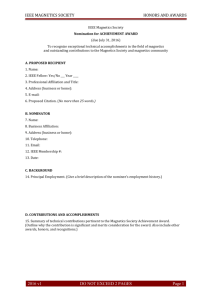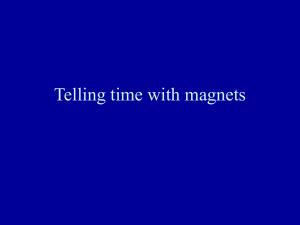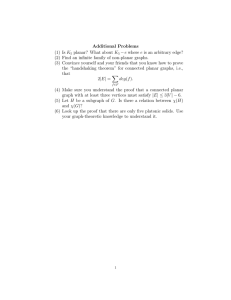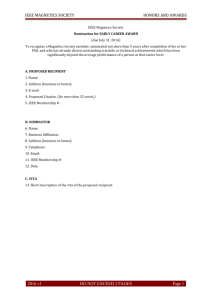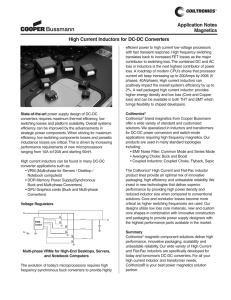The Benefits of Planar Magnetics in OF Power Conversion
advertisement
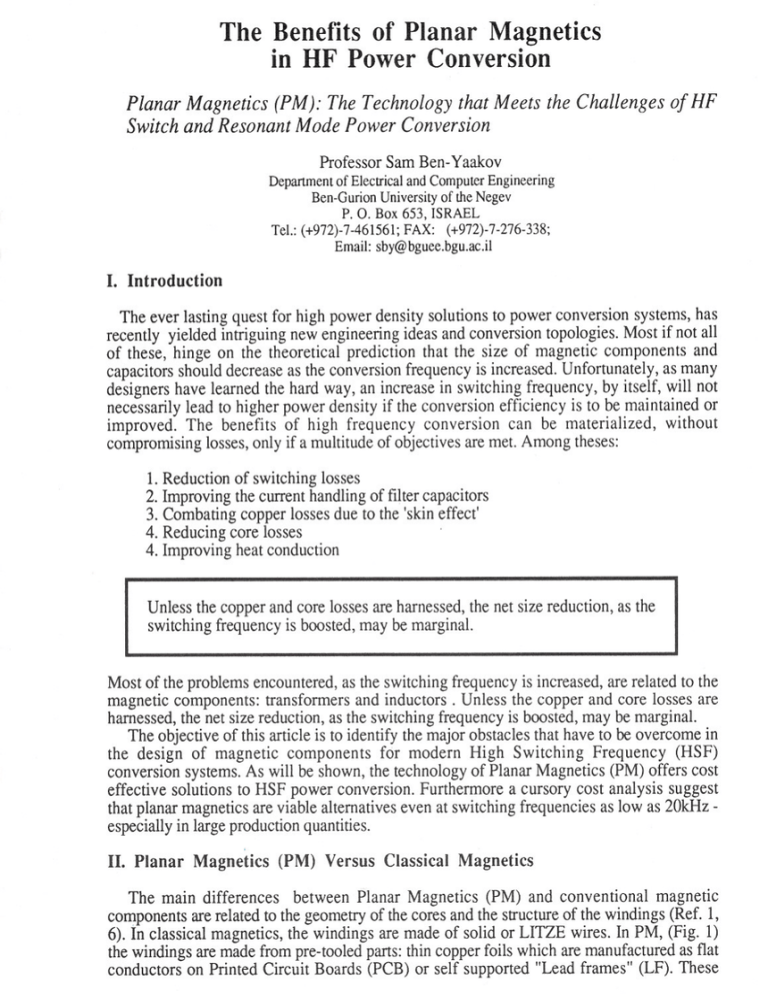
The Benefits of Planar Magnetics
in OF Power Conversion
Planar Magnetics (PM): The Technology that Meets the Challenges of HF
Switch and Resonant Mode Power Conversion
Professor Sam Ben-Yaakov
Department of Electrical and Computer Engineering
Ben-Gurion University of the Negev
P. O. Box 653. ISRAEL
Tel.: (+972)-7-461561; FAX: (+972)-7-276-338;
Email: sby@bguee.bgu.ac.il
I. Introduction
The ever lasting quest for high power density solutions to power conversion systems, has
recently yielded intriguing new engineering ideas and conversion topologies. Most if not all
of these, hinge on the theoretical prediction that the size of magnetic components and
capacitors should decrease as the conversion frequency is increased. Unfortunately, as many
designers have learned the hard way, an increase in switching frequency, by itself, will not
necessarily lead to higher power density if the conversion efficiency is to be maintained or
improved. The benefits of high frequency conversion can be materialized, without
compromising losses, only if a multitude of objectives are met. Among theses:
1. Reduction of switching losses
2. Improving the current handling of filter capacitors
3. Combating copper losses due to the 'skin effect'
4. Reducing core losses
4. Improving heat conduction
Unless the copper and core losses are harnessed, the net size reduction, as the
switching frequency is boosted, may be marginal.
Most of the problems encountered, as the switching frequency is increased, are related to the
magnetic components: transformers and inductors. Unless the copper and core losses are
harnessed, the net size reduction, as the switching frequency is boosted, may be marginal.
The objective of this article is to identify the major obstacles that have to be overcome in
the design of magnetic components for modern High Switching Frequency (HSF)
conversion systems. As will be shown, the technology of Planar Magnetics (PM) offers cost
effective solutions to HSF power conversion. Furthermore a cursory cost analysis suggest
that planar magnetics are viable alternatives even at switching frequencies as low as 20kHz especially in large production quantities.
II. Planar
Magnetics (PM) Versus Classical Magnetics
The main differences between Planar Magnetics (PM) and conventional magnetic
components are related to the geometry of the cores and the structure of the windings (Ref. 1,
6). In classical magnetics, the windings are made of solid or LITZE wires. In PM, (Fig. 1)
the windings are made from pre-tooled parts: thin copper foils which are manufactured as flat
conductors on Printed Circuit Boards (PCB) or self supported "Lead frames" (LF). These
2
S. Ben- Yaakov. The Benefits of Planar Magnetics in HF Power Conversion
parts (PCB & LF) with precisely defined winding positions, make it possible to predict with
high accuracy the geometry of PM magnetic parts and electrical specifications of planar
transformers and inductors.
Another major difference between the classical and PM magnetics is the ratio of ferrite to
copper volumes. A PM device will typically comprise of a core with a larger cross section
area but the windings will normally have smaller number of turns. This tradeoff is possible
since the magnetic flux density (B) of a magnetic material is a function of the product (n Ae»;
e Kd
B- n Ae
(1)
where:
B =magnetic flux density
n = number of turns
Ae = effective core cross section area
e = excitation; V-s (for transformers) or A-H (for inductors)
Kd = dimensional constant
(a)
Fig. 1.
(b)
(a) Picture of Planar Magnetics (PM) transformer.
(b) Exploded view of a Planar Magnetics (PM) transformer.
3
s. Ben-Yaakov, The Benefits of Planar Magnetics in HF Power Conversion
That is, an increase in cross section area allows a proportional decrease in the number of
turns. Furthermore, for both transformer and inductors the required' area product" (Ap) is
proportional to the power flowing through the magnetic device:
(2)
where:
Ap = area product
Ae= effective core cross section area
Aw =winding window area
E= energy handled by the magnetic device
Ke =constant
In planar magnetics, the ratio between the 'effective core cross section' and 'winding
window area' ( Aw /Ae) is smaller than the ratio in classical core structures (Ref. 2). This
geometry implies a smaller number of turns which in turn is highly compatible with
technology of foil windings ('lead frames' or PCB).
III. Winding Realization
in PM
Two winding structures are employed in PM: 'Lead frame' and PCB windings. The 'lead
frame' (Fig, 2(a» are self supported foil conductors which are shaped to fit the core as a
single turn. It is designed to carry heavy currents per the application. It is therefore suitable
for low voltage high current applications and can be used as a single or multiple layer
winding. The PCB approach (Fig. 2(b» is more suitable for a high voltage low current
winding and can also be applied as a single or multiple layer winding.
The technology of foil conductors applied in PM has many direct and indirect advantages
especially in high switching frequency applications.
Some of the advantages are related to copper loss while other are related to magnetic
properties of the devices.
Copper losses. A major source of loss at high switching frequency is due to the uneven
current distribution in current carrying conductors. Consequently, the 'AC resistance' could
be appreciably higher than the 'DC resistance' . The deviation is due to two major effects: the
skin effect' and 'proximity effect'. Both are caused, in the final analysis, by the interaction of
the electrical current and the magnetic fields associated by it. The 'skin effect' reflects the
influence of the magnetic field of a current carrying conductor on itself. The 'proximity
effect' is due to electromagnetic interaction between two neighboring conductors. Both will
push the current toward the surfaced and hence reduce the effective cross section of round
inductors. The foil inductors technology, applied in PM, helps to alleviate these problem by
realizing conductors with large surface area as compared to the width.
Leakage inductance. Leakage inductance represents the coupling imperfection between
primary and secondary windings in transformers. In many applications (e.g. Flyback
converters) ,the energy stored in this uncoupled inductor is lost, reducing thereby the overall
efficiency. The remedy to this problem is a reduction of the distance between the primary
and secondary windings. Hence, one would expect that the reduced number of turns and the
foil structure of the windings in PM will help to minimize the leakage inductance. Indeed,
PM transformers will have, in some cases, up to ten fold lower leakage than classical
transformers.
4
S. Ben- Yaakov, The Benefits of Planar Magnetics in HF Power Conversion
II
(a)
Fig. 2
I
PCBs
(b)
Lead Frame I (a) and PCB winding (b)
Leakage inductance. Leakage inductance represents the coupling imperfection between
primary and secondary windings in transformers. In many applications (e.g. Flyback
converters) ,the energy stored in this uncoupled inductor is lost, reducing thereby the overall
efficiency. The remedy to this problem is a reduction of the distance between the primary
and secondary windings. Hence, one would expect that the reduced number of turns and the
foil structure of the windings in PM will help to minimize the leakage inductance. Indeed,
PM transformers will have, in some cases, up to ten fold lower leakage than classical
transformers.
PM transformers will have up to ten fold lower leakage than classical
transformers.
5
S. Ben- Yaakov, The Benefits of Planar Magnetics in HF Power Conversion
IV. Core Losses
Core losses of magnetic material are mainly due to eddy currents and hysterisis losses. For
ferrites and powder cores, which are the economical solutions in modern switch and resonant
mode power conversion systems, the eddy losses are normally negligible small. This is due
to the fact that these magnetic materials exhibit a high volume resistivity. The hysterisis
losses per unit volume (Phys ) are found to be a non-linear function of the magnetic flux
swing (DB) and switching frequency (fs) (ref. 4, 5):
(3)
where:
Phys =hysterisis losses per unit volume
DB = magnetic flux density swing
fs = switching frequency
m = a constant in the range 2...3
n = a constant in the range 1...2
Kc = core loss constant
The conventional interpretation of this relationship is that as the frequency is increased the
magnetic flux swing (DB) must be reduced to keep the same loss level. The reduction of DB
calls for an increased cross section (Ae ) if the same number of turns are to be maintained
(equation I). On the other hand, an increase of (Ae) implies a larger core volume (V0) which
will increase the total core loss (Phys is defined per unit volume). One would therefore
prefer cores which exhibit a large cross section area but a relatively small volume. In PM, the
ratio of effective cross section to core volume (Ae No) is the largest (as compared to most
conventional cores, Ref. 2), making it advantageous in high switching frequency
applications.
V. Heat Dissipation
Thermal conduction between the 'hot spot' of the magnetic component will eventually
determine the useful power level of the device. Poor thermal conduction will cause unsafe
temperature rise and eventually a failure. In PM, the geometry leads to short thermal paths
and is characterized by large surface area which helps to dissipate the heat. Consequently,
PM designs are more economical since they allow a relatively higher power handling as
compared to classical magnetics. The power handling can be enhanced by choosing high
temperature electrical isolation material and by applying heat sinks. The large surface area of
PM can be conveniently and efficiently be connected to large surfaces with or without a fan.
All these can appreciably increase the power density of PM transformers.
VI. Availability.
The idea of PM magnetics and foil windings is not new and the benefits that it can be
offered have long been appreciated. However, application of this technology in production
lines has been hampered till now due to the lack of commercial availability of PM devices.
This is now changing. Multisource Technology Co.,( Boston, USA) and Payton Industries
Ltd. (Rishon-Lezion, Israel) are now offering a line of PM products covering the range of
few watts to 20 kW and a frequency range of 20kHz to IMHz. Considering the many
benefits of PM, this product availability is bound to convert the PM technology to a viable
and economical alternativein many designs.
6
S. Ben- Yaakov, The Benefits of Planar Magnetics in HF Power Conversion
Planar Magnetics could be beneficial and cost effective in the 20kHz to
IMHz range of conversion frequencies - especially in large production
quantities.
VII. Summary of PM Benefits
Comments
Advantage
High power density
Up to 3 times as compared to conventional
transfonners
.
Goodthennalconduction
Good Heat Dissioation
to 98% without volume increase
Shon thermal path, lower temperature rise
Bv attachinsrto chassis or heat sink
Low Profile
lications
Low leakasreinductance
Low EMI emission
Fixed, pre-tooled windinsrstructure
Efficient core shieldin
From about 20kHz to 1MHz
Availability
Available as samples and in production
uantities
REFERENCES
1. A. Estrov, 'Power transfonner design for 1 MHz resonant convener," Proc. of HFPC,
May 1986, pp. 36-54.
2. Magnetics, "Ferrite cores catalog," Magnetics, Butler, PA, 1994.
3. B. Andreycak, "Design review: 500W 40W/in3 Phase Shift ZVT Power Convener" ,
Unitrode SEM-900, 1993
4. Phillips Planar magnetic Components Catalog, COB 28, 1994.
5. Steef. A. Mulder, Philips Components."Loss fonnula for power ferrites and their use in
transfonner design."Feb. 94, 9398 082 97011.
5. Payton Inc., Planar Magnetics Catalogs: DCIDC, ACIDC, 1994.
.
iJ
.


